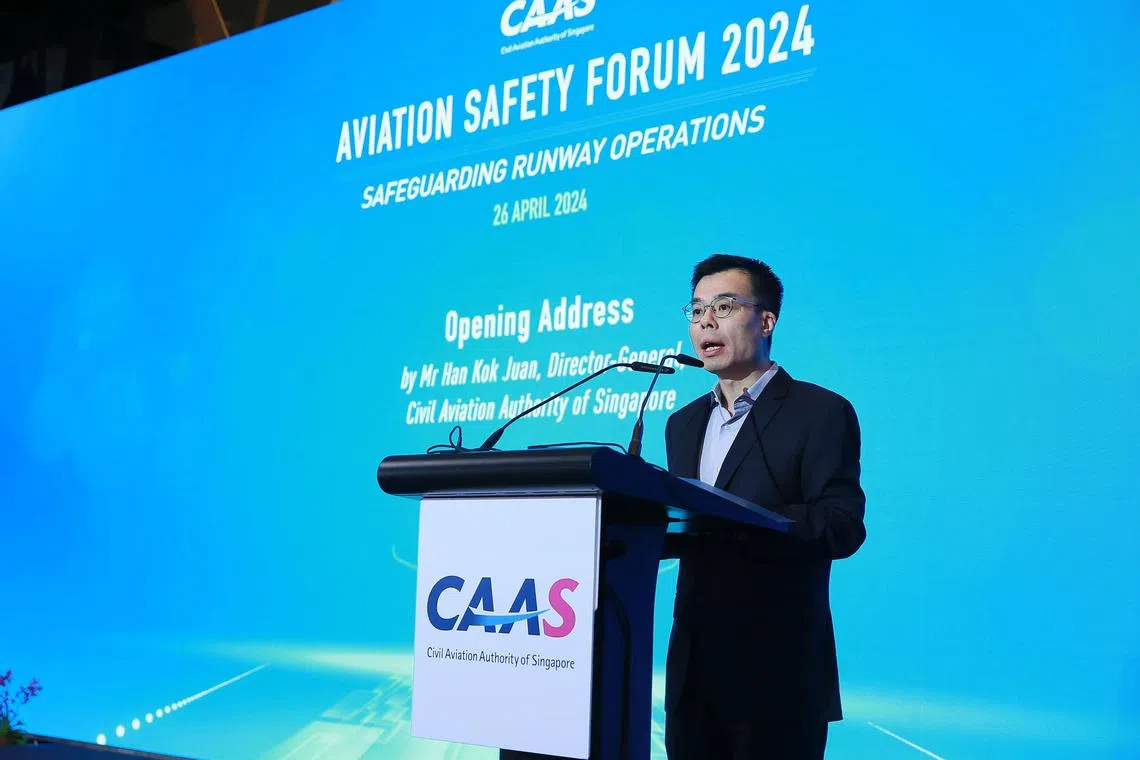Pay more attention to runway safety amid air traffic growth, urges CAAS chief
Sign up now: Get ST's newsletters delivered to your inbox

CAAS chief Han Kok Juan cautioned that growth in air passenger volume would lead to an increased workload, as well as more intense and complex operations.
PHOTO: CAAS
Follow topic:
SINGAPORE – The aviation industry should pay closer attention to runway safety, as Singapore’s air traffic approaches full recovery from pre-Covid-19 pandemic levels in 2024, said the Republic’s civil aviation chief.
Mr Han Kok Juan, director-general of the Civil Aviation Authority of Singapore (CAAS), said on April 26 that Changi Airport is expected to achieve a recovery to pre-pandemic levels or more for the full year, barring unforeseen circumstances.
Mr Han was speaking at the Aviation Safety Forum 2024 organised by CAAS at the Crowne Plaza Changi Airport hotel.
His comments came a day after airport operator Changi Airport Group announced that 16.5 million passengers passed through the airport
This is a 0.5 per cent increase from what the airport handled in the first quarter of 2019.
But Mr Han cautioned that this growth in air passenger volume would lead to an increased workload, and more intense and complex operations.
New safety challenges will emerge with a less experienced post-pandemic workforce, changes in weather patterns, concerns with original equipment manufacturers and disruptions to operations due to international conflicts, added Mr Han, who was speaking to some 300 key aviation staff at the forum.
Recounting the collision in January involving a Japan Airlines aircraft and a coast guard plane
In 2002, an Arrow Air freighter aircraft overran a runway at Changi Airport while landing in poor weather. In 2018, a South Korean flying display aircraft taking part in the Singapore Airshow skidded off the edge of a runway at Changi Airport during take-off.
While Singapore has not had any runway accidents since, at least six runway incursions took place at Changi and Seletar airports
These are incidents that involve the “incorrect presence” of an aircraft, vehicle or person on a runway designated for landing and take-off.
Ensuring runway safety, Mr Han said, involves complex systems and procedures, together with close collaboration among different players such as pilots and air traffic controllers.
This is essential as aircraft operate at high speeds near one another, and occasionally interact with other ground vehicles, he added.
Mr Han said CAAS is developing a new national aviation safety plan to deal with post-pandemic challenges for the next three years from 2025 to 2027, targeted to be published in the first quarter of 2025.
Given significant changes in the safety landscape over the last few years, he added that this new plan will be a timely update for the sector to identify and deal with new challenges comprehensively.
When contacted, CAAS said it will provide more details about the new plan when ready.
It follows the publication of an earlier safety plan in 2022 which aimed to address pandemic-related issues from 2022 to 2024,
These actions include reviewing flight crew reactivation and induction training, and increasing the frequency of safety oversight activities on aircraft that have been taken out of cold storage.
Mr Han said CAAS is on track to completing the safety actions under this plan.
He also brought up three key areas the aviation sector needs to continue working on to ensure runway safety: technology, human factors and collaboration.
On technology, Mr Han noted its importance in supporting human performance and easing workloads amid labour constraints, as well as in monitoring and analysing safety data to mitigate accidents.
For human factors, he spoke of training to deal with issues of performance and improved systems that account for human performance limitations.
There is also a need to foster collaboration within the industry, added Mr Han, citing an example of runway safety teams comprising various parties, including airlines, that meet every two months to discuss runway safety risks.
Other topics covered during the Aviation Safety Forum on April 26 included lessons learnt from runway operations and the role of human factors in runway safety.

